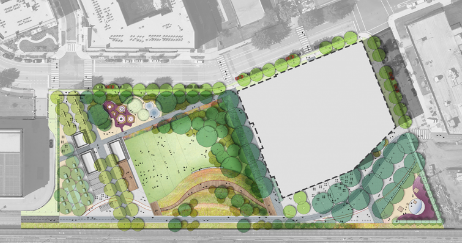
January 17, 2017
Stacie West
Director of Parks Projects
NoMa Parks Foundation
RE: Casey Trees’ Comments on the NoMa Green Competition Design
Dear Stacie West,
Casey Trees is a Washington DC-based nonprofit with a mission “to restore, enhance, and protect the tree canopy of the nation’s capital.” To fulfill this mission, we plant trees; monitor the city’s tree canopy; and work with decision makers, developers, and residents to encourage tree planting and protection on both public and private property.
We are dedicated to helping the District become a more livable community and reach its 40 percent tree canopy goal by 2032. As a city, we will achieve these goals when new development projects result in a meaningful increase in tree canopy. Therefore, we are excited to provide feedback to the NoMa Parks Foundation on the winning competition design for the NoMa Green, located north of New York Avenue NE and bounded by Harry Thomas Way NE and the Metropolitan Branch Trail.
Urban parks are essential components of a healthy community, providing recreation, inspiration, and respite from the city’s blare and bustle. Parks improve our physical and psychological health and make our neighborhoods more attractive places to live and work. In fact, parks are frequently cited as one of the most important assets in surveys of livable communities.
Just as other District neighborhoods have become identifiable by their parks, NoMa Green represents a tremendous opportunity to create a valuable and lasting green space for area residents. Therefore, we request an ambitious and robust tree planting plan for this community green space.
Below are Casey Trees’ responses to select questions posed by the NoMa Parks Foundation.
Competition Design Questions, Part 1
1. What do you like best about the park design?
The proposed increase in tree canopy, the selection of shade trees, and the variety of tree species are all steps in the right direction. Prioritizing large trees should be emphasized to maximize environmental benefits, and planting multiple tree species throughout the park will increase resilience, helping to achieve one of the District’s top goals in its Climate Ready DC Plan.
2. What do you like least about the park design?
Trees planted at this park will provide shade and other benefits to residents for generations. Therefore, we recommend maximizing tree planting along the street and MBT trail to provide a buffer from adjacent buildings and noise. To improve the park design, we suggest planting appropriate tree species for each location.
To be truly resilient, we also recommend following the 10-20-30 rule for tree diversity. This rule suggests plantings should include only 10% of any one species, 20% of any one genus and 30% of any family of trees. Consider working with Casey Trees to establish a planting plan or reference our Urban Tree Selection Guide to identify trees ideal for the park. Including a variety of trees will provide health benefits for park users, enhance aesthetic beauty, and support the District’s wildlife.
Competition Design Questions, Part 3
1. What aspects of sustainability and remediation suggested in the competition design appeal to you?
Natural areas are a key element of smart growth that address the public’s need for green space and the role of green space in mitigating problems of higher development density. In particular, we are pleased to see trees included in the proposed bioretention areas. Maximizing tree canopy in these bioretention areas will allow for more stormwater to be managed through interception, filtration, and evapotranspiration. Casey Trees’ Urban Tree Selection Guide identifies trees that thrive in rain gardens.
Thank you for the opportunity to comment. We would be happy to clarify any of the above recommendations or provide additional information. If you have any questions, please feel free to contact me at ktaddei@caseytrees.org.
Sincerely,
Kristin D. Taddei
Planning Advocate